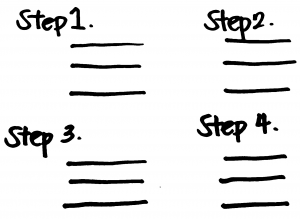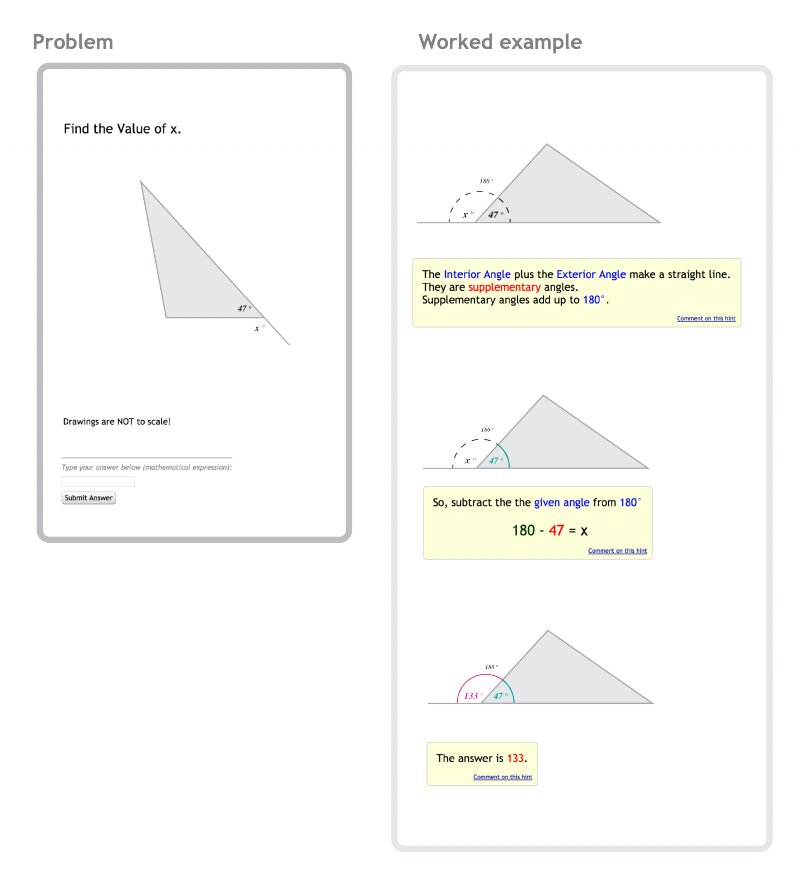Worked Examples
| Worked Examples | |
| Contributors | Paul Salvador Inventado, Peter Scupelli |
|---|---|
| Last modification | June 6, 2017 |
| Source | Inventado and Scupelli (in press 2015)[1]; Inventado and Scupelli (2015)[2] |
| Pattern formats | OPR Alexandrian |
| Usability | |
| Learning domain | General |
| Stakeholders | Teachers, Students |
| Production | |
| Data analysis | Student affect and interaction behavior in ASSISTments |
| Confidence | |
| Evaluation | eLearning Papers review PLoP 2015 shepherding and writing workshop Talk:ASSISTments |
| Application | ASSISTments |
| Applied evaluation | ASSISTments |
If a student doesn’t have an overview of how to solve the problem and where to begin, then provide a worked example so that students can have an overview of the procedures to follow[1][2].
Context
Students are answering problem-solving activities on an online learning system to get practice with a particular type of skill. Students are implementing the design pattern Try It Yourself.
Problem
Some students may be motivated to solve a problem, but do not know where to begin, and do not want to muddle their way through hints without an overview of the problem solving process first.
Forces
- Prior knowledge. Students may be unable to solve a problem if they forget key facts, concepts, and processes[3].
- Randomness. When students do not know how to solve a problem, they may randomly combine elements to form a solution that may not solve the problem or even confuse themselves further[4].
- Affective entry. When students are unable to achieve their learning goals, they may become frustrated, discouraged of their abilities, and dislike the subject [5].
- Limited resources. Students may eventually give up if they are unable to solve the problem[6]
Solution
Therefore, provide a worked example so that students can have an overview of the procedures to follow. Worked examples show a step-by-step process of solving a problem similar to the type of problem the student is currently asked to solve. Students may request for a worked example themselves, or the system could show the worked example automatically when a given condition is satisfied (e.g., too many incorrect attempts, too many hint requests, student’s answer is very different from the expected answer).
Consequences
Benefits
- Worked examples help students form new knowledge, which they can use to solve the current problem and similar problems in the future.
- Students can pattern their solution on the worked example instead of finding solutions on their own.
- Students will be more confident in their abilities and develop interest in the subject when they successfully apply the solution.
- Worked examples may help guide students to solve the problem that they were not able to solve themselves[7]
Liabilities
- Teachers and content experts will also need to provide worked examples for the problems they create.
- The worked example may give away too much information (e.g., student would have already remembered the process if only two out of five steps were presented).
- The online learning system will need to identify when to provide the worked example. Showing it too soon may take away possible learning opportunities, but showing it too late may no longer be helpful.
Evidence
Literature
Expert guidance can help students achieve difficult tasks within the Zone of Proximal Development, which they are unable to do on their own[7]. Worked examples are one way of guiding student learning. It gives a step-by-step demonstration of how to perform a task or solve a problem. It helps novice learners form basic knowledge structures, which they can use to acquire new knowledge and skills through practice[8].
Discussion
Shepherds, writing workshop participants, and learning system stakeholders (i.e., data mining experts, learning scientists, and educators) agreed that the design pattern’s solution could address the identified problem.
Data
ASSISTments online learning system data showed that students rapidly requested for all available hints when they did not know how to solve the problem (i.e., based on hint request and answer correctness features). Students could have used hints as a proxy for worked examples, which showed them the entire procedure for solving the problem.
Example
Worked examples are common strategies used in online learning systems to support student learning. Both Cognitive Tutor Algebra and Cognitive Tutor Geometry provide a button that students can click to request for a worked example[9][10]. The ASSISTments online learning system also supports the creation of worked examples for problem solving activities[11]. It gives content creators the flexibility in controlling where to attach the worked example and when to show it (e.g., hint, scaffold, scaffold on incorrect response).
The figure below illustrates an example of a geometry problem and an associated worked example. It shows a step-by-step process of solving for the angle x, but uses a different problem so as not to give away the answer.
Related patterns
The Worked Examples design pattern can be used to support student learning when they implement the Try It Yourself, Different Exercise Levels, or Build and Maintain Confidence design patterns.
References
- ↑ 1.0 1.1 Inventado, P.S. & Scupelli, P. (in press 2015). A Data-driven Methodology for Producing Online Learning System Design Patterns. In Proceedings of the 22nd Conference on Pattern Languages of Programs (PLoP 2015). New York:ACM.
- ↑ 2.0 2.1 Inventado, P. S. & Scupelli, P. (2015). Towards an open, collaborative repository for online learning system design patterns. eLearning Papers, 42(Design Patterns for Open Online Teaching):14-27.
- ↑ Hume, G., Michael, J., Rovick, A., and Evens, M. (1996). Hinting as a tactic in one-on-one tutoring. The Journal of the Learning Sciences, 5(1), 23-47.
- ↑ Sweller, J. (2004). Instructional design consequences of an analogy between evolution by natural selection and human cognitive architecture. Instructional science, 32(1-2), 9-31.
- ↑ Bloom, B. S. (1974). Time and learning. American psychologist, 29(9), 682.
- ↑ D’Mello, S., and Graesser, A. (2012). Dynamics of affective states during complex learning. Learning and Instruction, 22(2), 145-157.
- ↑ 7.0 7.1 Vygotsky, L. S. (1962). Language and thought. Massachusetts Institute of Technology Press, Ontario, Canada.
- ↑ Clark, R. C., and Mayer, R. E. (2011). E-learning and the science of instruction: Proven guidelines for consumers and designers of multimedia learning. John Wiley & Sons.
- ↑ Aleven, V., Mclaren, B., Roll, I., and Koedinger, K. (2006). Toward meta-cognitive tutoring: A model of help seeking with a Cognitive Tutor. International Journal of Artificial Intelligence in Education, 16(2), 101-128.
- ↑ Koedinger, K. R., and Aleven, V. (2007). Exploring the assistance dilemma in experiments with cognitive tutors. Educational Psychology Review, 19(3), 239-264.
- ↑ Weitz, R., Salden, R. J. C. M., Kim, R. S., and Heffernan, N. T. (2010). Comparing worked examples and tutored problem solving: Pure vs. mixed approaches. In Proceedings of the Thirty-Second Annual Meeting of the Cognitive Science Society (pp. 2876-2881).

